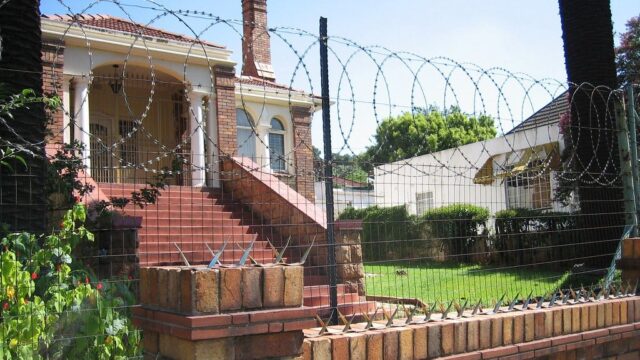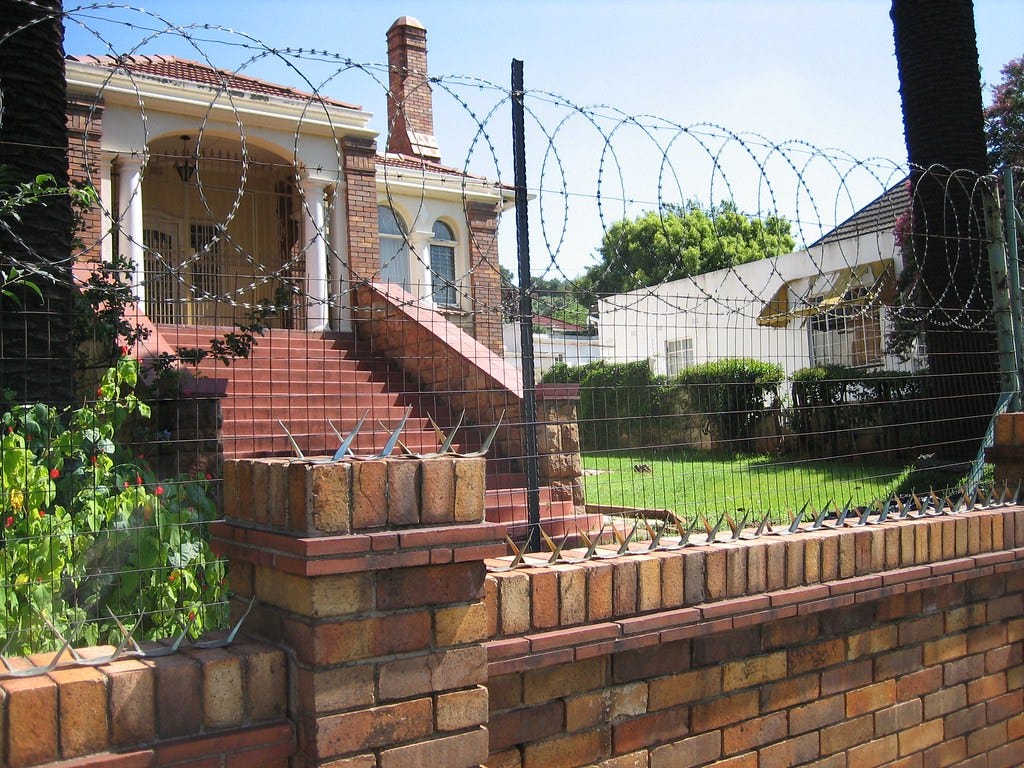The Blight of Black-on-White Crime in South Africa

Note: In December 2011, I visited South Africa for two weeks to compose a journalistic piece on the state of the Afrikaner people since the end of Apartheid in 1994. That article eventually ran in a journal which is now out of print. But with Afrikaners in the news again these days, I thought it would be appropriate to republish portions of this article, in order to provide context for the complex historical situation facing the “white tribe” today.
In this portion of the article, I focus on how the Afrikaners I met constantly reported constantly feeling themselves and their loved ones to be at risk of bodily harm in the deeply corrupt, ANC-ruled, post-Apartheid dispensation.
These days, following the implosion of the Apartheid regime and the advent of true “democracy” in 1994, which has ushered in nearly two decades of rule by the Black-dominated African National Congress, Johannesburg is newly notorious… as the unofficial rape and murder capital of the world.
For this reason, I—a nervous flyer—feel a strange combination of relief and apprehension as we touch down at O.R. Tambo (formerly Jan Smuts) airport. “Out of the frying pan, into the fire,” is a phrase that thrusts itself into my exhausted mind as I file out of the plane and shuffle through customs alongside my weary fellow travelers.
Of course, I am being (slightly) overly dramatic. Johannesburg is a very dangerous city, but—much lurid tabloid-like propaganda to the contrary— it isn’t exactly a war zone. If you exercise proper caution and avoid doing foolish or reckless things or going to obviously dodgy locations, you should be okay.
Still, one is immediately struck by the extent to which living and working units in the area are conspicuously fortified. Nearly every private residence and business location in the Gauteng province—an area which includes Jo’burg and its sister city Pretoria, as well as the infamous township Soweto—is a mini castle-keep, complete with a high palisades electric fence, with barbed wires curlicued across the top, and one security company or another advertised prominently at the front.
No resident of the area can simply visit a neighbor by walking up to his front door and knocking or ringing the doorbell; instead, you have to buzz in at the front entrance, and wait for your neighbor to trust that you aren’t a thief, a murderer, or a rapist, before allowing you to obtain entrance by activating the automatic gate.

One is tempted to wonder if this setup isn’t a hysterical overreaction on the part of Whites to the undeniably real crime problem in South Africa. But the more I talked to individual Afrikaners, the more I felt inclined to believe that these fastidious security precautions are eminently reasonable, even necessary.
Indeed, it seems that everyone has a horror story of some form or fashion to tell, either of a family member or a friend, on a farm or in a city or in a sleepy suburban locale, who became a victim of an awful act of aggravated violence. . . A cousin of one man was relaxing in his home watching a rugby match on TV on a Sunday afternoon, when suddenly a gang of Black hoodlums entered; one of them made a run at his wife in the living room, and as he rushed to protect her, he was shot and killed… A woman’s uncle and aunt were savagely tortured and murdered in their home one night, and nothing was even stolen from the house. . . A fellow in his mid-30s relates that a friend of his once stopped to assist a group of young Black men on the roadway whose car had supposedly broken down; in so doing, he walked right into an ambush—the men attempted an armed robbery, and the friend was gunned down in the ensuing melee. . . Another man opens up about how his girlfriend was carjacked in broad daylight—she found herself set upon by four Blacks with guns at a busy intersection; fearing a gang rape, she left the keys in the ignition and fled in a panic…. A mother tells me of a girl who was suddenly attacked by a Black man with a machete, who hacked her to death without provocation on a dark street one night….
Then there are the less shocking, more numerous accounts of petty muggings here and there; ever-present “smash and grab” raids, whereby a criminal walks up to an unsuspecting motorist, shatters his window with a crowbar or other solid object, reaches in to snatch the driver’s purse or Blackberry from the dashboard or passenger seat; or simple home burglaries which take place while the homeowner is at work or out of town.
To be sure, Afrikaners and other Whites aren’t the only victims of crime—many decent, law-abiding Blacks have also been robbed, raped, and murdered—but there seems evidence to deduce that not a few native Blacks have turned on the Boer nation— their former rulers—with a particularly hateful ferocity. Indeed, illegal and nominally legal activity seem to stem from a similar motivation.
The ruling ANC government frequently changes the names of Afrikaans roads and locations in a transparent effort to punish the people who they felt oppressed them in the past, and imposes quite insane racial quotas upon businesses and social services—even to the point where, for example, prospective black doctors in medical school are held to far less rigorous standards than their White counterparts, in order to increase the representation of Black doctors (never mind, I suppose, how well they treat the sick!).
White farmers, meanwhile, are asked to cede ever more of their private property in the interests of agricultural affirmative action; meanwhile, farm murders continue apace in a steady, dreary campaign of terror.
The details of the murders and assaults of Afrikaner farm families are often upsetting in the extreme: children are raped; elderly couples are made to drink acid and set on fire; one hears of new, bloodcurdling attacks nearly every month. According to credible statistics, there have been nearly 2,000 murders of farmers and their family members since 1991, and the numbers, while fluctuating from year to year, show no signs of abating.
Many have become convinced that the government is in fact behind the murders, whether through deliberate manipulation or as a result of irresponsible, vindictive anti-White rhetoric and propaganda, creating an atmosphere of hate. In Pretoria, I speak with three representatives of the Transvaal Agricultural Union (TAU), who openly declare their strong suspicion that some governmental authorities are complicit in the killings. General director Bennie van Zyl notes that many of the murders seem to take place in areas where the ANC has agitated for a greater degree of “land reform.” (Under the stipulations of “Black Economic Empowerment,” or “BEE” policies, farmers are required to let their black employees have part of their land after a certain number of years of employment.)
“There is certainly a link between violent attacks on farms and land claims,” declares van Zyl. “In provinces where the land claims are big, the attacks are big.”

Van Zyl draws a link between what is happening to Afrikaner farmers in South Africa and what has happened all over the continent from time to time when one tribe or group seeks to dispossess another, the most egregious recent example being the savage massacre of the Tutsis by the Hutus in Rwanda in the mid-‘90s.
“It’s a pattern in the whole of Africa,” he says. “And I don’t think that the Western world recognizes this pattern. It’s very hard for us Afrikaners to understand it, and we grew up with those guys (the Blacks).” Using language that would make most North American and European Westerners, liberal or otherwise, blanch and titter as if they’d just heard a dirty joke, Van Zyl claims that in his view, it is simply a part of the African’s nature and mindset to conduct such murderous campaigns. “We (White Afrikaners) believe in God, but they (Blacks) believe in the power of their ancestors,” Van Zyl says. “We accept responsibility, while they replace responsibility. Their leaders want them to be perceived as a people with a deep-seated value system that attaches value to life, but the practice is very different.”
The world largely knows about the depredations of Robert Mugabe and his Zanu-PF Party in neighboring Zimbabwe. In that country, Mugabe’s forces have systematically forced the White farmers off of their land, bankrupting many and physically attacking others. As a result, a once relatively prosperous African country has turned into a blighted, impoverished scourge of a land.
When I ask if South Africa might become the next Zimbabwe, the representatives of the TAU respond that it’s already happening, simply in a covert manner. “It’s a case of a velvet glove covering an iron hand,” says TAU service manager Chris van Zyl.
I shed my liberal leftism long ago, in my undergraduate years, and today I call myself a moderate racialist, yet I find myself discomfited by the implication that Black Africans have some sort of natural proclivity towards ruthless violence. I also find it hard to accept that the ANC, incompetent and corrupt as it may be, has actually organized a murderous campaign against White farmers. I admit as much to these men, who in response own that not all Blacks are culturally depraved; many, in fact, are perfectly nice people.
However, they also ruefully note that the current ruling political party of South Africa—one of whose rally songs is “Kill the Boer, Kill the Farmer”—isn’t exactly falling over itself trying to make a priority of stopping the farm murders, or stopping Black-on-White violent crime in general.
Even if they aren’t directly complicit, these men maintain, the African National Congress has very little interest, if any, in protecting Afrikaners from harm.
“If there is crime, it suits the ANC,” says Bennie van Zyl. “The purpose of terrorism is to terrorize.”
https://andynowicki.substack.com/p/the-blight-of-black-on-white-crime
